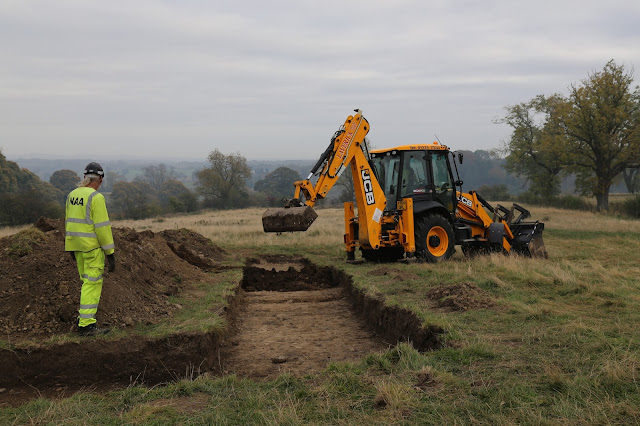Thanks to everyone who came along to the Brignall open day last
Saturday (17th October). The event was really well attended, with between 30 to
40 people visiting the site over the course of the day.
The signs are up and ready to go.
Thanks especially to our stalwart team of local diggers who gave up their site cabin for the day so we could lay out
some of the finds from the excavation. Charlotte, one of our busy
post-excavation team, was on hand in the morning to talk through the discoveries, including a fine fragment of Neolithic or Bronze Age pottery from Trench 1.
This has been one of the most exciting finds of the season as the discover of such material is
very rare. However, the small shred proudly on display was trounced in the
afternoon when a large piece of pottery of the same date was found onsite. We
will keep you updated as to progress on the significance of these finds. After the dig is complete they will be sent for full analysis and dating.
Displays posted up on the site hut
Alongside the prehistoric material, there was also pottery,
bone, glass and ironwork found in association with the medieval occupation being
excavated in Trenches 2 and 3. In addition, Charlotte brought along the NAA finds
handling collection, which includes a range of material you might find on a
medieval dig like Brignall. This was a particular hit with the younger visitors
to the site.
Finds on display in the site hut. Thanks to Charlotte (above) for explaining the various finds
Out in the trenches, Penny, Martyn and our director, Richard
Fraser, showed people around the site, explaining a little bit about the strategy
behind the location of the trenches, the pre-excavation surveys and the
progress of the dig itself. They talked to groups of very interested
visitors about the various deposits and structures exposed, as well as
about the process of digging. Poor Martyn was so busy in Trench 1 that he never
got any time for his lunch! Thanks for your help Martyn, you did a great job.
Martyn busy at Trench 1
All in all, it was a very successful day and a great
opportunity for local people to see what we have been up to over the past 2
week. Although we are really pleased to have secured a third week of digging at
Brignall, the trenches will be backfilled on Friday, so there will not be
another chance to see the site. Please do keep watching this blog, and our
facebook site, for updates on the post-excavation. There should also,
hopefully, be further opportunities for volunteers to take part in the finds and
environmental sample processing.
Thanks everyone who came along and contributed to a great day
While all is coming to a close at Brignall, it is full speed ahead at Hawksley Hill. More of that tomorrow, but excavation will be beginning
on the new site on Friday 23rd October and running for ten days until Tuesday
3rd November, including the two Saturdays. Excavations at Hawksley will be
concentrated on exposing an area around two known pieces of prehistoric Rock
Art. We have already undertaken a few test pits to inform the excavation strategy
and it is all looking very promising, with indications of a possible
associated prehistoric surface.
If you would like further information on the Hawksley Hill then
please contact penny at pm@naa.gb.com


















